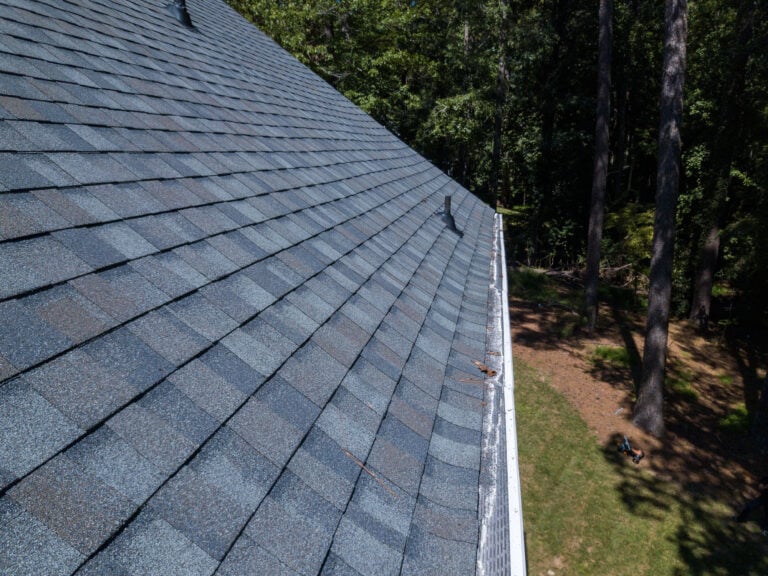When life throws a storm your way, and your roof takes a beating, it’s time to roll up your sleeves and take action. Roof damage can lead to leaks and further costly repairs if left unaddressed. But don’t worry, because in this quick and easy guide, we’ll show you how to tarp a roof to protect your home from further water damage. Let’s dive in and get your roof patched up like a pro!
Inside this blog:
- The importance of tarping your roof
- 9 DIY steps for effectively placing a tarp on your roof
Ready to learn how to patch up your roof so you can stay shielded from the elements? Start scrollin’!
Why Tarps Matter ☔
Before we jump into the how-tos, let’s understand why tarps are crucial when it comes to protecting your damaged roof.

Prevent Further Damage
A tarp serves as a temporary barrier against rainwater, preventing it from seeping through damaged areas of your roof. This prevents additional water damage to your home’s interior.
Buy Time for Repairs
By tarping your roof, you buy valuable time to schedule and carry out proper roof repairs. Roofing professionals may not be immediately available, especially during a storm, so a tarp can act as a stopgap measure.
Save on Repairs
Timely tarping can minimize the extent of water damage, potentially saving you money on repairs. It’s a cost-effective way to protect your home while you wait for permanent solutions.
Tools + Materials You Will Need 🧰
Before you begin tarping your roof, gather the necessary tools and materials to make the process smoother. Here’s a quick checklist:
- Heavy-duty tarps: Purchase tarps large enough to cover the damaged area with some overhang. Reinforced, waterproof tarps are the best choice.
- Wooden boards or 2x4s: These will be used to secure the tarp in place.
- Rope or bungee cords: You’ll need these to tie down the tarp securely.
- A ladder: To access your roof safely.
- Work gloves: Protect your hands during the process.
- A utility knife or scissors: For cutting the tarp to the desired size.
The Step-by-Step Guide 🛠️
Now that you have your tools and materials ready, it’s time to tarp your roof. Follow these 9 steps carefully:
1. Safety First
Before climbing up to your roof, ensure that the weather conditions are safe. Do not attempt to tarp your roof during a storm, high winds, or slippery conditions. Your safety is the top priority.
2. Locate the Damage
Identify the damaged area of your roof. Look for missing shingles, holes, or other points where water can enter.
3. Measure and Cut the Tarp
Unroll the tarp on the ground and measure it to cover the damaged area with some overhang. Use a utility knife or scissors to cut the tarp to the desired size.
4. Secure Wooden Boards
Place wooden boards or 2x4s along the edges of the tarp. These will help anchor the tarp and prevent it from flying away in the wind.
5. Climb the Ladder
Carefully climb the ladder to access your roof. Ensure the ladder is stable and placed on a level surface.
6. Position the Tarp
Gently lift the tarp onto the roof and position it over the damaged area. Allow the overhang to drape over the roof’s edge.
7. Secure the Tarp
Use rope or bungee cords to secure the tarp in place. Start by tying down the corners and edges of the tarp to the wooden boards or 2x4s you placed earlier. Ensure the tarp is taut and won’t shift in the wind.

8. Check for Leaks
Inspect the area around the tarp for any gaps or openings. If you notice any, use additional tarps or materials to cover them and prevent water from seeping through.
9. Monitor the Tarp
Keep an eye on the tarp over the next few days, especially if the weather remains adverse. Make any necessary adjustments to ensure it continues to protect your roof.
When to Call in the Pros 📞
Tarping your roof is a useful temporary solution, but it’s not a substitute for proper roof repairs. Here are situations when you should call in roofing professionals:
- Extensive Damage: If your roof has suffered severe damage, multiple leaks, or structural issues, professional help is necessary.
- Safety Concerns: If you are uncomfortable with heights or roof work, it’s safer to leave it to the experts.
- Insurance Claims: Document the damage and consult with your insurance company. They may require an assessment from a professional roofer.
Roof Repair vs. Roof Replacement
Tarping can buy you time for repairs, but it’s essential to assess the overall condition of your roof. Depending on the extent of the damage, you might need either repairs or a full roof replacement. Here are some factors to consider:
Repair:
- Localized Damage: If the damage is confined to a specific area, repairs may be sufficient.
- Age of the Roof: If your roof is relatively new and the damage is minor, repairs can extend its lifespan.
- Budget: Repairs are usually more budget-friendly than a full replacement.
Replacement:
- Extensive Damage: Severe damage, widespread leaks, or an aging roof may require replacement.
- Roof Age: If your roof is nearing the end of its expected lifespan, replacement may be a better long-term solution.
- Energy Efficiency: Upgrading to more energy-efficient roofing materials during replacement can lead to long-term savings.
Tarp Your Roof For a Safer Home
Tarping a damaged roof is a practical and cost-effective way to prevent further water damage to your home. By following the steps outlined in this guide and knowing when to call in professionals, you can protect your investment and buy valuable time for necessary repairs or roof replacement. Remember that safety should always come first, and if in doubt, seek expert assistance to ensure your roof is in the best possible condition.
Contact our expert team of roofers at Palladium Roofing today and experience top-notch workmanship and speedy turnaround times. Let’s keep your home standing strong with a resilient and beautiful roof!





